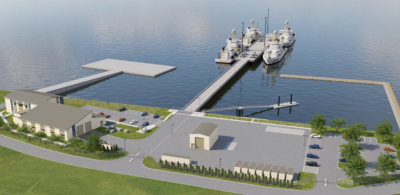Downstream turbulence from offshore wind turbines can reduce power generation at nearby turbines, substantially reducing the total potential from planned U.S. offshore wind projects, according to recent research from the Colorado University Boulder and National Energy Technology Laboratory.
The researchers’ paper published March 14 in the journal Wind Energy Science suggests that offshore wind turbines off the U.S. East Coast could rob neighboring turbine arrays of wind speed and thus power generation depending on daily conditions, by more than 30%.
“As a result, the wind slows down and becomes more turbulent behind the turbines. This means the turbines downstream get slower wind, sometimes resulting in lower power generation,” according to a Colorado State University summary of the research.
Most of the potential loss to power generation will occur within individual turbine arrays, from wake effect slowing wind speeds to some turbines.
“Using computer simulations and observational data of the atmosphere, the team calculated that the wake effect reduces total power generation by 34% to 38% at a proposed wind farm off the East Coast,” according to the University of Colorado. ”Most of the reduction comes from wakes formed between turbines within a single farm.”
“But under certain weather conditions, wakes could reach turbines as far as 55 kilometers (34 miles) downwind and affect other wind farms. For example, during hot summer days, the airflow over the cool sea surface tends to be relatively stable, causing wakes to persist for longer periods and propagate over longer distances.”
Wake effects are a potential factor for offshore wind projects off southern New England, where the 804-megawatt Vineyard Wind project under construction is underway with others lined up for nearby leases developers obtained from the federal Bureau of Ocean Energy Management.
Even with the lower power production estimated in their study, Colorado State researchers still estimate “the proposed wind farms could still supply approximately 60% of the electricity demand of the New England grid, which covers Connecticut, Maine, Massachusetts, New Hampshire, Rhode Island, and Vermont.”
Wake effect has long been recognized by researchers. The potential density of turbine arrays on BOEM leases off southern New England has focused more attention on wake effect, and could reduce real-time operational power outputs far lower than the so-called “nameplate” ratings of those projects.
“The U.S. is planning to build thousands of offshore wind turbines, so we need to predict when those wakes will be expensive and when they have little effect,” said Julie Lundquist, a professor in the Colorado State University Department of Atmospheric and Ocean Sciences, who is also a fellow at CU Boulder’s Renewable and Sustainable Energy Institute.
Using computer simulations and observational data of the atmosphere, the team calculated that wake effect can reduce total power generation by 34% to 38% at a proposed wind farm off the East Coast. Most of the reduction comes from wakes formed between turbines within a single farm.
That effect could increase during hot summer days, because airflow over the cool sea surface tends to be relatively stable, causing wakes to persist for longer periods and propagate over longer distances.
“Unfortunately, summer is when there's a lot of electrical demand,” said Dave Rosencrans, a doctoral student at CU and lead author of the study. “We showed that wakes are going to have a significant impact on power generation. But if we can predict their effects and anticipate when they are going to happen, then we can manage them on the electrical grid.”





